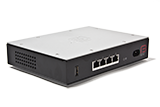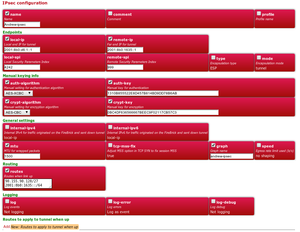FireBrick IPsec Tunnel with Manual Keys (Deprecated): Difference between revisions
No edit summary |
No edit summary |
||
| Line 1: | Line 1: | ||
[[File:2700-small.png|link=:Category:FireBrick]] |
[[File:2700-small.png|link=:Category:FireBrick]] |
||
=FireBrick IPSec Information= |
|||
Information from May 2013: |
|||
The IPSec feature provides ESP with ESP-auth and a choice of algorithms to create tunnels with a static config for keys. Blowfish is the fastest, if you have a choice. Triple DES is slowest, as you may expect. |
|||
At present the code can be used to create point to point fixed IP tunnels between FireBricks, or FireBrick and linux boxes. Other routers/VPN boxes may be able to handle fixed configs like this too. |
|||
Next we will be doing IKE (key exchange) which is more commonly used to establish session keys. We also plan to link in IPSec and L2TP which is commonly used for PCs and mobiles to VPN connect as an endpoint. More on this as we release it. |
|||
...this is all in-house code at every level with our own crypto libraries following the RFCs. We control every line of code in the FireBricks and the IPSec code is no exception. |
|||
This is an alpha release, and may well have bugs and issues that we need to work on, so we welcome feedback as usual. Please ensure crash logs are emailed as normal so we can pick up any fatal exceptions. |
|||
=FireBrick to FireBrick= |
=FireBrick to FireBrick= |
||
Revision as of 11:16, 28 June 2013
FireBrick IPSec Information
Information from May 2013:
The IPSec feature provides ESP with ESP-auth and a choice of algorithms to create tunnels with a static config for keys. Blowfish is the fastest, if you have a choice. Triple DES is slowest, as you may expect.
At present the code can be used to create point to point fixed IP tunnels between FireBricks, or FireBrick and linux boxes. Other routers/VPN boxes may be able to handle fixed configs like this too.
Next we will be doing IKE (key exchange) which is more commonly used to establish session keys. We also plan to link in IPSec and L2TP which is commonly used for PCs and mobiles to VPN connect as an endpoint. More on this as we release it.
...this is all in-house code at every level with our own crypto libraries following the RFCs. We control every line of code in the FireBricks and the IPSec code is no exception.
This is an alpha release, and may well have bugs and issues that we need to work on, so we welcome feedback as usual. Please ensure crash logs are emailed as normal so we can pick up any fatal exceptions.
FireBrick to FireBrick
Here we will create a tunnel between 2 firebricks, Paul and Andrew. We will then set routing to route each others LAN blocks though the Tunnel. As the 2 endpoints have IPv6, we'll establish the tunnel over IPv6.
Side A Config
<ipsec name="Andrew-ipsec" mtu="1500" graph="andrew-ipsec" local-ip="2001:8b0:d6:1::1" remote-ip="2001:8b0:1635::1" local-spi="4242" remote-spi="999" auth-algorithm="AES-XCBC" auth-key="1310B855522E8D457B814BD9DD78B6AB" crypt-algorithm="AES-CBC" crypt-key="0BC4DF636566667BEEC9F02117CB57C3" routes="90.155.90.128/27 2001:8b0:1635::/64"/>
| IPSec settings overview | |
|---|---|
| name | Just a name for this Tunnel |
| mtu | |
| graph | Just a name so as to create a CQM graph |
| local-ip | Our FireBrick IP to use as the source |
| remote-ip | Remote FireBrick IP |
| local-spi | |
| remote-spi | |
| auth-algorithm | |
| auth-key | |
| crypt-algorithm | |
| crypt-key | |
| routes | IP blocks to route through the tunnel - ie LAN IPs of the other end |
name="Andrew-ipsec" mtu="1500" graph="andrew-ipsec" local-ip="2001:8b0:d6:1::1" remote-ip="2001:8b0:1635::1" local-spi="4242" remote-spi="999" auth-algorithm="AES-XCBC" auth-key="1310B855522E8D457B814BD9DD78B6AB" crypt-algorithm="AES-CBC" crypt-key="0BC4DF636566667BEEC9F02117CB57C3" routes="90.155.90.128/27 2001:8b0:1635::/64"/>
Side B Config
<ipsec name="Paul-ipsec" mtu="1500" graph="paul-ipsec" local-ip="2001:8b0:1635::1" remote-ip="2001:8b0:d6:1::1" local-spi="999" remote-spi="4242" auth-algorithm="AES-XCBC" auth-key="1310B855522E8D457B814BD9DD78B6AB" crypt-algorithm="AES-CBC" crypt-key="0BC4DF636566667BEEC9F02117CB57C3" routes="91.241.56.1 81.2.97.160/27 91.241.56.0/24 2001:8b0:d6::/48"/>
Testing
These 2 FireBricks both happen to be on AAISP FTTC lines, and a normal traceroute would go via the AAISP router, but when the IPSec tunnel is enabled the traceroute goes direct.
Traceroute Before:
$ traceroute 91.241.56.1 traceroute to 91.241.56.1 (91.241.56.1), 30 hops max, 60 byte packets 1 brick.h.hearn.org.uk (90.155.90.129) 0.344 ms 0.321 ms 0.310 ms 2 a.gormless.thn.aa.net.uk (90.155.53.51) 11.703 ms 11.712 ms 11.834 ms 3 brick.shibboleet.ltd.uk (91.241.56.1) 24.862 ms 24.871 ms 25.251 ms
Traceroute After:
$ traceroute 91.241.56.1 traceroute to 91.241.56.1 (91.241.56.1), 30 hops max, 60 byte packets 1 brick.h.hearn.org.uk (90.155.90.129) 0.358 ms 0.342 ms 0.329 ms 2 brick.shibboleet.ltd.uk (91.241.56.1) 26.178 ms 26.861 ms 27.123 ms


